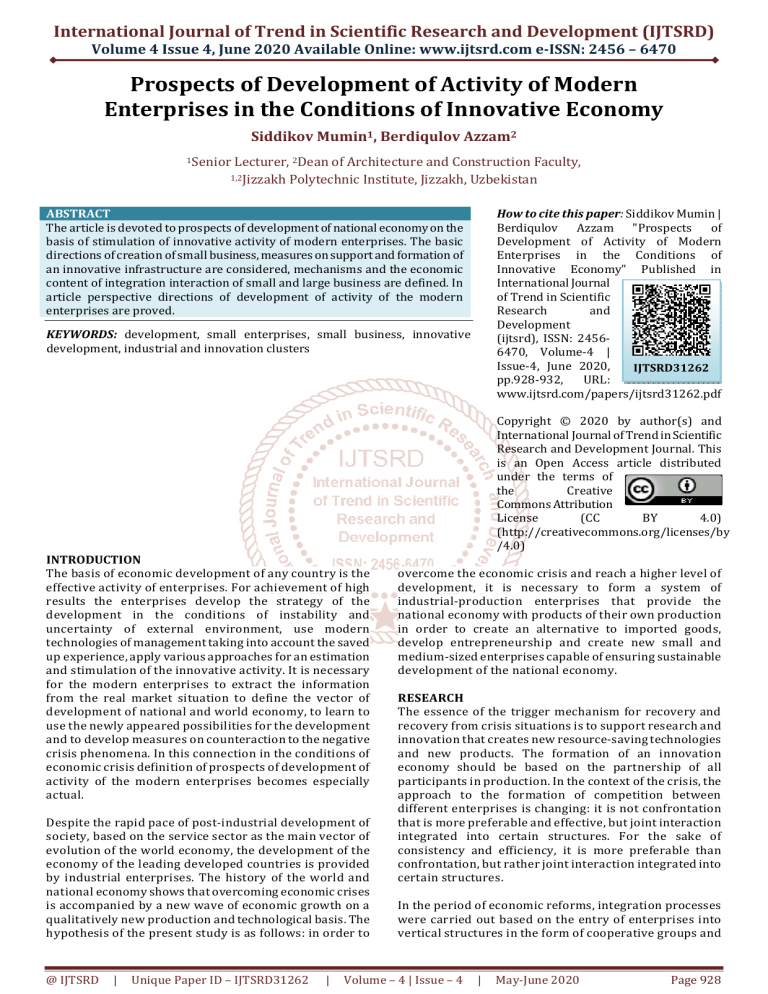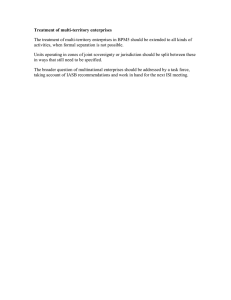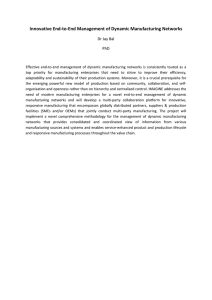
International Journal of Trend in Scientific Research and Development (IJTSRD)
Volume 4 Issue 4, June 2020 Available Online: www.ijtsrd.com e-ISSN: 2456 – 6470
Prospects of Development of Activity of Modern
Enterprises in the Conditions of Innovative Economy
Siddikov Mumin1, Berdiqulov Azzam2
1Senior
Lecturer, 2Dean of Architecture and Construction Faculty,
1,2Jizzakh Polytechnic Institute, Jizzakh, Uzbekistan
How to cite this paper: Siddikov Mumin |
Berdiqulov Azzam "Prospects of
Development of Activity of Modern
Enterprises in the Conditions of
Innovative Economy" Published in
International Journal
of Trend in Scientific
Research
and
Development
(ijtsrd), ISSN: 24566470, Volume-4 |
Issue-4, June 2020,
IJTSRD31262
pp.928-932,
URL:
www.ijtsrd.com/papers/ijtsrd31262.pdf
ABSTRACT
The article is devoted to prospects of development of national economy on the
basis of stimulation of innovative activity of modern enterprises. The basic
directions of creation of small business, measures on support and formation of
an innovative infrastructure are considered, mechanisms and the economic
content of integration interaction of small and large business are defined. In
article perspective directions of development of activity of the modern
enterprises are proved.
KEYWORDS: development, small enterprises, small business, innovative
development, industrial and innovation clusters
Copyright © 2020 by author(s) and
International Journal of Trend in Scientific
Research and Development Journal. This
is an Open Access article distributed
under the terms of
the
Creative
Commons Attribution
License
(CC
BY
4.0)
(http://creativecommons.org/licenses/by
/4.0)
INTRODUCTION
The basis of economic development of any country is the
effective activity of enterprises. For achievement of high
results the enterprises develop the strategy of the
development in the conditions of instability and
uncertainty of external environment, use modern
technologies of management taking into account the saved
up experience, apply various approaches for an estimation
and stimulation of the innovative activity. It is necessary
for the modern enterprises to extract the information
from the real market situation to define the vector of
development of national and world economy, to learn to
use the newly appeared possibilities for the development
and to develop measures on counteraction to the negative
crisis phenomena. In this connection in the conditions of
economic crisis definition of prospects of development of
activity of the modern enterprises becomes especially
actual.
Despite the rapid pace of post-industrial development of
society, based on the service sector as the main vector of
evolution of the world economy, the development of the
economy of the leading developed countries is provided
by industrial enterprises. The history of the world and
national economy shows that overcoming economic crises
is accompanied by a new wave of economic growth on a
qualitatively new production and technological basis. The
hypothesis of the present study is as follows: in order to
@ IJTSRD
|
Unique Paper ID – IJTSRD31262
|
overcome the economic crisis and reach a higher level of
development, it is necessary to form a system of
industrial-production enterprises that provide the
national economy with products of their own production
in order to create an alternative to imported goods,
develop entrepreneurship and create new small and
medium-sized enterprises capable of ensuring sustainable
development of the national economy.
RESEARCH
The essence of the trigger mechanism for recovery and
recovery from crisis situations is to support research and
innovation that creates new resource-saving technologies
and new products. The formation of an innovation
economy should be based on the partnership of all
participants in production. In the context of the crisis, the
approach to the formation of competition between
different enterprises is changing: it is not confrontation
that is more preferable and effective, but joint interaction
integrated into certain structures. For the sake of
consistency and efficiency, it is more preferable than
confrontation, but rather joint interaction integrated into
certain structures.
In the period of economic reforms, integration processes
were carried out based on the entry of enterprises into
vertical structures in the form of cooperative groups and
Volume – 4 | Issue – 4
|
May-June 2020
Page 928
International Journal of Trend in Scientific Research and Development (IJTSRD) @ www.ijtsrd.com eISSN: 2456-6470
the creation of horizontal associative formations. It should
be noted that in the 1990s, along with the unification of
enterprises, there was also their "crushing" and
disaggregation as a result of privatization processes,
which was inevitable in the conditions of formation of
market economy in our country. Economists note a
significant growth in the number of international strategic
alliances with the participation of Uzbek companies in the
late 1980s - early 1990s. The creation of strategic
alliances allowed Uzbek companies to gain access to
knowledge and technologies, new markets and methods of
competition. The formation of such strategic alliances was
carried out in the form of joint ventures and created more
favorable conditions for foreign partners: it ensured that
foreign companies would enter the Uzbek market at a
lower cost and risk. This form of integration is justified
from the point of view of the need to attract new
technologies to develop the activities of domestic
enterprises that Table 1 shows that, between 2008 and
2016, the number of enterprises and organizations which
is implementing innovation activities.
Table1. Innovative activity of enterprises and organizations
2008
2009
2010
2011
2012
2013
2014
Number of enterprises and
organizations implementing
innovations:
Technological
268
140
145
185
164
725
819
Marketing
15
4
1
2
9
14
13
Organizational
21
7
3
9
14
22
20
Number of implemented
innovations:
Technological
578
462
462
818
624
1262
1382
Marketing
58
42
32
9
17
32
41
Organizational
47
23
6
15
58
40
42
Volume of innovative products
produced (goods, works and
1325,1 1660,4 1849,0 1348,7 3635,9 4614,7 7043,0
services), billion soums
Costs of innovation, billion
521,5
333,7
264,4
372,6
311,9 4634,2 3757,4
soums
Source: www.stat.uz
2015
2016
894
14
27
893
20
20
1737
36
46
1816
51
39
8023,6
10688,2
5528,3
2571,4
In 2016, 933 enterprises and organizations implemented innovations throughout the country, most of them, namely 893 (96%
of the total number of organizations), implemented technological activities in their activities, and the remaining 40 - marketing
and organizational innovations.
Picture1. Introduction of innovations in 2016
In 2016, about 2000 innovations were introduced by more than 900 organizations and enterprises of the Republic of
Uzbekistan. At the same time, most of the innovations introduced, i. 1,816 of them were directed to the modernization of
enterprises with the involvement of new efficient technologies. This means that the introduction of innovations in our country
is mainly due to the import of machinery and equipment from abroad.
@ IJTSRD
|
Unique Paper ID – IJTSRD31262
|
Volume – 4 | Issue – 4
|
May-June 2020
Page 929
International Journal of Trend in Scientific Research and Development (IJTSRD) @ www.ijtsrd.com eISSN: 2456-6470
Picture2. Structure of implemented innovations in 2016
In addition, the number of employees engaged in scientific
research and experimental development in the Republic of
Uzbekistan has not changed significantly over the past 16
years.
For definition of prospects of development of innovative
activity of the Uzbek enterprises it is necessary to analyze
the data on financing of scientific researches and
developments and to define the basic directions of
development.
The analysis of these indicators shows that funding for
scientific research almost doubled in 2016 (1.89)
compared to 2008, but this did not lead to a similar
increase in the innovation activity of domestic enterprises
in the period under review, as shown in Table 1. In order
to increase the level of innovation activity of Uzbek
enterprises, it is not enough to use only one direction of
stimulation in the form of increased funding for scientific
research. It is expedient to develop integration forms of
interaction of the small, average and large enterprises, to
connect efforts of the state, a science and business in the
field of innovative workings out, to create industriallyinnovative clusters of the enterprises for as much as
possible effective realization of all stages of life cycle of
innovative process and maintenance of successful
commercialization of new products and technologies.
The concept of innovative development of modern
enterprises, taking into account national and regional
policy priorities. This concept allows the definition of a
set of measures to stimulate the innovative activity of
domestic enterprises.
Stimulation of innovative activity of the domestic
enterprises should be carried out comprehensively and
systematically in the following main directions:
development and implementation of an investment
technology expansion policy for the "revival" of
national industry;
formation and application of the mechanism of tax
incentives for innovation activity;
providing soft loans and state guarantees as a form of
security for loans issued to finance innovative
projects;
@ IJTSRD
|
Unique Paper ID – IJTSRD31262
|
creation of special infrastructure to support and
develop innovative entrepreneurship;
protection of interests and intellectual property
rights of innovative enterprises when entering
domestic and foreign markets;
forming a system of state orders for innovative
research and development.
Innovative projects are implemented on the basis of
consistent and interconnected implementation by all
participants of the innovation life cycle stages, from the
moment of development and creation to the following not
only to successfully complete the innovation cycle on the
basis of natural specialization and expedient division of
innovative functions, but also to realize their economic
interests as effectively as possible and get new
opportunities for the development of their own innovative
activity, using the accumulated knowledge and
experience. Thus, in the process of realization of
innovative cycle the mechanism of stimulation of
innovative activity of its participants on the basis of
synergetic effect of innovative activity at the expense of
efficiency is put.
Tendencies of development of mutual relations between
the enterprises of small, medium and large business are of
great importance for formation of innovative economy.
The developed system of effective cooperation of different
forms of pre-enterprise is a sign of developed modern
economy. It is well known that large companies have the
necessary potential for the implementation and
development of innovative technologies.
However, small enterprises are able to respond more
flexibly to changing market demands and quickly adopt
new technologies. World practice shows that the use of
cooperation increases the efficiency of large companies,
especially it is relevant in the field of production, where
the implementation of technological and product
innovations. Beyond the crisis, the government supports
systemically important large companies, which in turn
should invest resources in the development of small and
medium-sized businesses. It is no coincidence that today
the state policy is aimed at creating and developing small
and medium-sized enterprises in the innovation sphere.
Volume – 4 | Issue – 4
|
May-June 2020
Page 930
International Journal of Trend in Scientific Research and Development (IJTSRD) @ www.ijtsrd.com eISSN: 2456-6470
The innovative synergy of interaction of small, medium
and large enterprises is most clearly manifested in the
process of creation of industrial-innovative clusters. Small
innovative enterprises play a key role in the structure of
the innovation cluster. They are created with the support
of business incubators from the fund for the promotion of
small enterprises in science and technology, private
investors and large companies. The cooperation of small,
medium and large enterprises in the framework of the
creation of an innovation infrastructure to support
entrepreneurship contributes to the following objectives:
enables the distribution of responsibility and shares
of risk associated with innovation;
promotes the development of new technologies and
ensures their rapid introduction into production;
creates conditions for regular and continuous market
research and monitoring;
stimulates the development of new production
facilities in order to create additional jobs;
enables a more efficient use of the experience and
resources of the innovation process participants.
The practice has developed certain forms of interaction
between small and large businesses, among which the
main ones are:
joint activities;
using a franchise system;
transfer of certain functions under outsourced
conditions;
subcontracting;
the organization of mediation activities.
Formation of industrial and innovation clusters involves
the use of a contractual system of relationships between
different enterprises. In its essence, it resembles the
Soviet system of state for the Uzbek people, but in the
conditions of innovative economy has certain features:
enterprises independently determine the nature of
relationships based on the needs and demands of the
market for their innovative products; formation of
industrial and innovation clusters.
The mechanism of integration interaction of participants
of innovative process is understood as set of methods and
means of association, concentration of resource potential
and possibilities of the small, average and large
enterprises for as much as possible effective realization of
the innovative project and achievement of the purposes
and tasks in view. The mechanism of integration
interaction of economic subjects in the conditions of
innovative economy consists of the following elements:
creation of small enterprises in the interests of large
businesses for the development of innovative ideas,
the organization of small-scale production of
innovative products, the possibility of conducting
tests and experiments, organization of service
maintenance of innovative products;
unification of enterprises into cluster chains to
strengthen
the
innovation
orientation
of
development, formation of scientific bases of
production organization, creation of a consistent
technological chain of innovation development,
improvement of innovation commercialization
mechanism;
formation of a "team" of innovation process
@ IJTSRD
|
Unique Paper ID – IJTSRD31262
|
participants taking into account the specialization and
competence of each economic entity with the
distribution of rights, obligations, responsibilities and
results;
development of stable horizontal links between
enterprises and formation of unions and associations
of innovation process participants for successful
implementation of projects and minimization of
economic risks;
development of small and medium business in the
field of outsourcing to ensure a smooth production
process, freeing high-tech enterprises from laborintensive work and strengthening their specialization.
The data in Table-1 reflect the current situation in the
sphere of small business, when the most attractive for
creation and development of small business are
commerce and services. In order to create a national
innovation economy, it is necessary to develop an
industry that is able to balance the raw materials sector
and create a decent alternative to imported products and
technologies. Therefore the production of high-tech
products for various industries and services should
become a priority in the creation of innovative small
enterprises in their close cooperation with large
businesses. For the successful functioning of small
businesses in priority areas of domestic industry
development, it is necessary to create an innovation
support infrastructure, which includes the creation of
technopolises, technoparks and innovation centres,
business incubators, technology transfer centres, etc. The
establishment of technoparks on the basis of large
industrial enterprises with the participation of scientific
organizations and higher education institutions will allow
small enterprises to have access to industrial sites and
ensure their prospects of "post-incubation" development.
Unfortunately, today this direction is not sufficiently
implemented in practice, which significantly complicates
the possibility of integrated development of innovation
activities of small and medium-sized enterprises in close
cooperation with large businesses, as well as does not
allow the most effective implementation of the full
innovation cycle in industrial production.
Foreign experience demonstrates need for targeted
government support for the business sector. Innovative
partnership between business and government is
implemented in various forms, taking into account current
and strategic attitudes. The government has defined the
priorities of the transition from the raw materials to the
innovation model of economic development, planned to
carry out industrial modernization, planned activities to
build a chain from idea and development to the
production of the final innovative product. Special tools
have been developed to implement the state innovation
policy:
financial support for scientific developments in the
form of grants, loans, subsidies;
formation of special economic zones, science cities,
technology parks, technology transfer;
establishment of special state corporations, a venture
fund and a public-private partnership system;
application of measures in the field of tax incentives;
improvement of the legislation on innovation.
Prospects of development of activity of the modern
Volume – 4 | Issue – 4
|
May-June 2020
Page 931
International Journal of Trend in Scientific Research and Development (IJTSRD) @ www.ijtsrd.com eISSN: 2456-6470
enterprises in many respects today are defined by the
chosen directions of the state innovative policy:
energy efficiency and energy saving, including the
development of new fuels;
nuclear technology;
space
technologies,
primarily
related
to
telecommunications;
medical technology, including medical equipment and
pharmaceuticals;
strategic information technologies, including
supercomputing and software development.
These activities have been selected on the basis of existing
achievements and developments in these areas and are
capable of producing a multiplier effect and becoming a
catalyst in related industries. Creation of integration
forms of interaction and cooperation of small, medium
and large enterprises with the participation of the state
and science in the above directions will allow to
purposefully form industrial and innovation clusters for
implementation of a single strategy of innovative
development of the national economy.
CONCLUSION
Modern enterprises seek resources and opportunities for
innovative development, which involves not only the
organization of the process of innovation, but also the
formation of the resource
The system of interaction with other 2. economic subjects.
The experience of foreign countries shows that mutual
cooperation of small, medium and large enterprises brings
tangible results in the field of innovation, expressed in a
synergetic effect at the expense of emergence and
interdependence of participants in the innovation process.
Definition of prospects of development of activity of the
modern enterprises should be coordinated with directions
of development of a state innovative policy that assumes
effective use of available stocks in high technology areas
taking into account priorities of solving social questions in
the conditions of overcoming economic crisis.
REFERENCES
[1] Azamat Berdiyorov, Temur Berdiyorov (2020)
LONG-RANGE PLANNING OF A PUBLIC TRANSPORT
COMPANY. Journal of Critical Reviews, 7 (6), 700703. doi:10.31838/jcr.07.06.122
[2] Azamatovich, B. T. (2019). Indo–Asian Journal of
Multidisciplinary Research (IAJMR).
[3] Azamatovich, B. T. (2019). Ways of Using Innovative
Marketing Technologies in the Passenger Transport
System. Asian Journal of Technology & Management
Research (AJTMR) ISSN, 2249(0892).
[4] Corsi, C., & Akhunov, A. (2000). THE LEGAL
PROTECTION OF SCIENTIFIC AND RESEARCH
INNOVATION IN UZBEKISTAN. Innovation and
Market Globalization: The Position of SME's, 31, 45.
[5] Corsi, C., & Akhunov, A. (Eds.). (2000). Innovation
and Market Globalization: The Position of SME's (Vol.
31). IOS Press.
[6] Hornidge, A. K., Ul Hassan, M., & Mollinga, P. P.
(2011). Transdisciplinary innovation research in
Uzbekistan–one
year
of
‘Follow-theInnovation’. Development in Practice, 21(6), 834-847.
[7] https://doi.org/10.37200/IJPR/V24I10/PR300229
[8] https://doi.org/10.37200/IJPR/V24I8/PR280658
[9] Konstantin, K. (2015). Innovation component of the
business environment as a factor enhancing
economic growth. Economics, (1 (2)).
[10] Ul Hassan, M., & Hornidge, A. K. (2010). ‘Follow the
Innovation’–The second year of a joint
experimentation and learning approach to
transdisciplinary research in Uzbekistan.
[11] Ul-Hassan, M., & Hornidge, A. K. (2010). Follow the
Innovation. The
second
year
of
a
joint
experimentation and learning approach to
transdisciplinary research in Uzbekistan. ZEF
Working Paper Series. Vol, 63.
[12] Бердиёров, Т. А., & Ортиков, Ё. Ю. (2016). Понятие
мотивации трудовой деятельности. Молодой
ученый, (7-2), 83-86.
@ IJTSRD
|
Unique Paper ID – IJTSRD31262
|
Volume – 4 | Issue – 4
|
May-June 2020
Page 932




